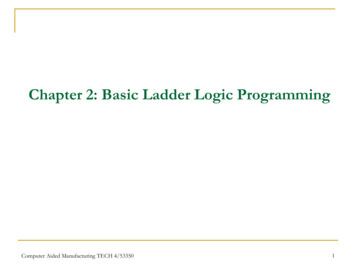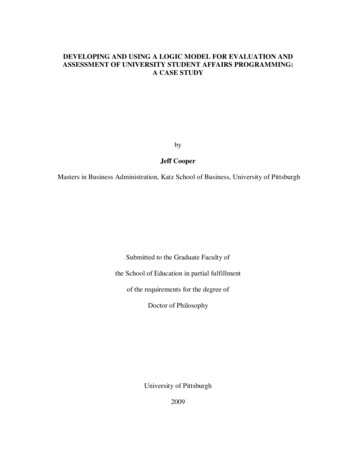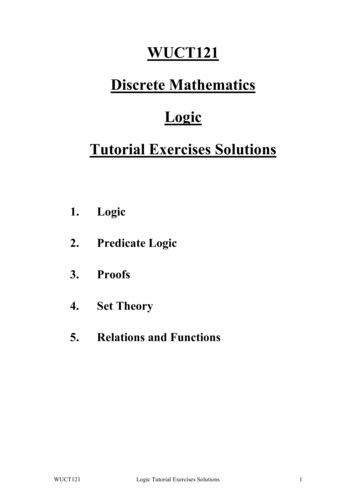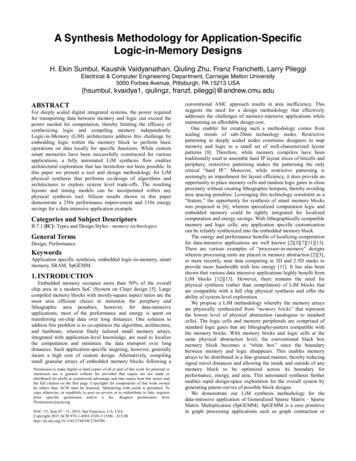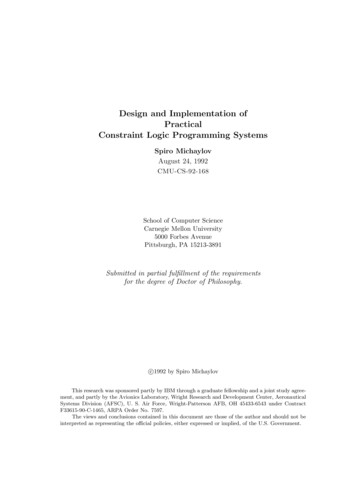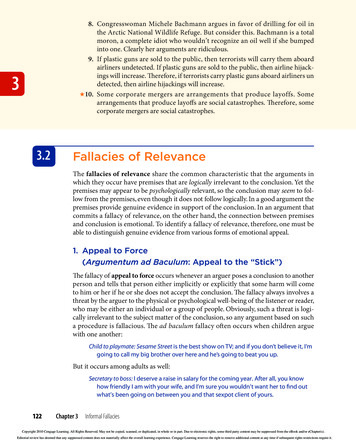
Transcription
8. Congresswoman Michele Bachmann argues in favor of drilling for oil inthe Arctic National Wildlife Refuge. But consider this. Bachmann is a totalmoron, a complete idiot who wouldn’t recognize an oil well if she bumpedinto one. Clearly her arguments are ridiculous.9. If plastic guns are sold to the public, then terrorists will carry them aboardairliners undetected. If plastic guns are sold to the public, then airline hijackings will increase. Therefore, if terrorists carry plastic guns aboard airliners undetected, then airline hijackings will increase. 10. Some corporate mergers are arrangements that produce layoffs. Somearrangements that produce layoffs are social catastrophes. Therefore, somecorporate mergers are social catastrophes.33.2Fallacies of RelevanceThe fallacies of relevance share the common characteristic that the arguments inwhich they occur have premises that are logically irrelevant to the conclusion. Yet thepremises may appear to be psychologically relevant, so the conclusion may seem to follow from the premises, even though it does not follow logically. In a good argument thepremises provide genuine evidence in support of the conclusion. In an argument thatcommits a fallacy of relevance, on the other hand, the connection between premisesand conclusion is emotional. To identify a fallacy of relevance, therefore, one must beable to distinguish genuine evidence from various forms of emotional appeal.1. Appeal to Force(Argumentum ad Baculum: Appeal to the “Stick”)The fallacy of appeal to force occurs whenever an arguer poses a conclusion to anotherperson and tells that person either implicitly or explicitly that some harm will cometo him or her if he or she does not accept the conclusion. The fallacy always involves athreat by the arguer to the physical or psychological well-being of the listener or reader,who may be either an individual or a group of people. Obviously, such a threat is logically irrelevant to the subject matter of the conclusion, so any argument based on sucha procedure is fallacious. The ad baculum fallacy often occurs when children arguewith one another:Child to playmate: Sesame Street is the best show on TV; and if you don’t believe it, I’mgoing to call my big brother over here and he’s going to beat you up.But it occurs among adults as well:Secretary to boss: I deserve a raise in salary for the coming year. After all, you knowhow friendly I am with your wife, and I’m sure you wouldn’t want her to find outwhat’s been going on between you and that sexpot client of yours.122Chapter 3Informal FallaciesCopyright 2010 Cengage Learning. All Rights Reserved. May not be copied, scanned, or duplicated, in whole or in part. Due to electronic rights, some third party content may be suppressed from the eBook and/or eChapter(s).Editorial review has deemed that any suppressed content does not materially affect the overall learning experience. Cengage Learning reserves the right to remove additional content at any time if subsequent rights restrictions require it.
The first example involves a physical threat, the second a psychological one. While neither threat provides any genuine evidence that the conclusion is true, both provide evidence that someone might be injured. If the two types of evidence are confused witheach other, both arguer and listener may be deluded into thinking that the conclusionis supported by evidence, when in fact it is not.The appeal to force fallacy usually accomplishes its purpose by psychologically impeding the reader or listener from acknowledging a missing premise that, ifAppeal to forceThreatensAPosR /LA ArguerR /L Reader/ListeneresConclusionacknowledged, would be seen to be false or at least questionable. The two examplesjust given can be interpreted as concealing the following premises, both of which aremost likely false:If my brother forces you to admit that Sesame Street is the best show on TV, thenSesame Street is in fact the best show.If I succeed in threatening you, then I deserve a raise in salary.The conclusion of the first argument is that Sesame Street is the best show on TV.But just because someone is forced into saying that it is does not mean that such is thecase. Similarly, the conclusion of the second argument is that the secretary deserves araise in salary. But if the boss is threatened into raising the secretary’s salary, this doesnot mean that the secretary deserves a raise. Many of the other informal fallacies canbe interpreted as accomplishing their purpose in this way.2. Appeal to Pity(Argumentum ad Misericordiam)The appeal to pity fallacy occurs when an arguer attempts to support a conclusion bymerely evoking pity from the reader or listener. This pity may be directed toward thearguer or toward some third party. Example:Taxpayer to judge: Your Honor, I admit that I declared thirteen children as dependentson my tax return, even though I have only two. But if you find me guilty of tax evasion, my reputation will be ruined. I’ll probably lose my job, my poor wife will notbe able to have the operation that she desperately needs, and my kids will starve.Surely I am not guilty.The conclusion of this argument is “Surely I am not guilty.” Obviously, the conclusion is not logically relevant to the arguer’s set of pathetic circumstances, although itSection 3.2Fallacies of Relevance123Copyright 2010 Cengage Learning. All Rights Reserved. May not be copied, scanned, or duplicated, in whole or in part. Due to electronic rights, some third party content may be suppressed from the eBook and/or eChapter(s).Editorial review has deemed that any suppressed content does not materially affect the overall learning experience. Cengage Learning reserves the right to remove additional content at any time if subsequent rights restrictions require it.3
Appeal to pityEvokespityAPos3R /LA ArguerR /L Reader/ListeneresConclusionis psychologically relevant. If the arguer succeeds in evoking pity from the listener orreader, the latter is likely to exercise his or her desire to help the arguer by acceptingthe argument. In this way the reader or listener may be fooled into accepting a conclusion that is not supported by any evidence. The appeal to pity is quite common and isoften used by students on their instructors at exam time and by lawyers on behalf oftheir clients before judges and juries.Of course, some arguments that attempt to evoke sympathetic feelings from thereader or listener are not fallacious. We might call them arguments from compassion.Such arguments differ from the fallacious appeal to pity in that, in addition to evokingcompassion on behalf of some person, they supply information about why that person is genuinely deserving of help or special consideration. Whenever possible thesenonfallacious arguments should show that the person in question is a victim of circumstances and not responsible for the dire straits he finds himself in, that the recommended help or special consideration is not illegal or inappropriate, and that it willgenuinely help the person in question. In contrast to such arguments, the appeal topity proceeds by ignoring all of these considerations and attempts to support a conclusion by merely evoking pity from the reader or listener.3. Appeal to the People(Argumentum ad Populum)Nearly everyone wants to be loved, esteemed, admired, valued, recognized, and acceptedby others. The appeal to the people uses these desires to get the reader or listener toaccept a conclusion. Two approaches are involved: one of them direct, the other indirect.The direct approach occurs when an arguer, addressing a large group of people, excitesthe emotions and enthusiasm of the crowd to win acceptance for his or her conclusion.The objective is to arouse a kind of mob mentality. This is the strategy used by nearlyevery propagandist and demagogue. Adolf Hitler was a master of the technique, butspeech makers at Democratic and Republican national conventions also use it with somemeasure of success. Waving flags and blaring music add to the overall effect. Because theindividuals in the audience want to share in the camaraderie, the euphoria, and the excitement, they find themselves accepting a variety of conclusions with ever-increasing fervor.An appeal to negative emotions, such as suspicion and fear, can also generate amob mentality. These emotions have produced many lynchings, and they led to theinternment of Japanese Americans during World War II. Also, the direct approach is124Chapter 3Informal FallaciesCopyright 2010 Cengage Learning. All Rights Reserved. May not be copied, scanned, or duplicated, in whole or in part. Due to electronic rights, some third party content may be suppressed from the eBook and/or eChapter(s).Editorial review has deemed that any suppressed content does not materially affect the overall learning experience. Cengage Learning reserves the right to remove additional content at any time if subsequent rights restrictions require it.
not limited to oral discourse. The same effect can be accomplished in writing. By usingsuch emotionally charged phrasing as “fighter of communism,” “champion of the freeenterprise system,” and “defender of the working man,” polemicists can awaken thesame kind of mob mentality as they would if they were speaking.In the indirect approach the arguer aims his or her appeal not at the crowd as awhole but at one or more individuals separately, focusing on some aspect of their relationship to the crowd. The indirect approach includes such specific forms as the bandwagon argument, the appeal to vanity, and the appeal to snobbery. All are standardtechniques of the advertising industry.Appeal tothe peopleAPlays on needfor security, etc.PosesR /LA ArguerR /L Reader/ListenerConclusionHere is an example of the bandwagon argument:Of course you want to buy Zing toothpaste. Why, 90 percent of America brushes with Zing.The idea is that you will be left behind or left out of the group if you do not use the product.The appeal to vanity often associates the product with someone who is admired,pursued, or imitated, the idea being that you, too, will be admired and pursued ifyou use it. The recent television and billboard ads for the U.S. Marine Corps providean example. The ads show a strong, handsome man in uniform holding a gleamingsword, and the caption reads:The Few, the Proud, the Marines.The message is that if you join the Marines, then you, too, will be admired andrespected, just like the handsome man in the uniform.The appeal to snobbery depends on a similar kind of association.A Rolls-Royce is not for everyone. If you qualify as one of the select few, thisdistinguished classic may be seen and driven at British Motor Cars, Ltd. (Byappointment only, please.)Needless to say, the indirect approach is used not only by advertisers:Mother to child: You want to grow up and be just like Wonder Woman, don’t you?Then eat your liver and carrots.These examples illustrate how the indirect version of the appeal to the people canoverlap the false cause fallacy, which is presented in Section 3.3. Thus, the previousexample might be interpreted to suggest that eating liver and carrots will cause one tobecome just like Wonder Woman. If so, the fallacy could be identified as false cause.Section 3.2Fallacies of Relevance125Copyright 2010 Cengage Learning. All Rights Reserved. May not be copied, scanned, or duplicated, in whole or in part. Due to electronic rights, some third party content may be suppressed from the eBook and/or eChapter(s).Editorial review has deemed that any suppressed content does not materially affect the overall learning experience. Cengage Learning reserves the right to remove additional content at any time if subsequent rights restrictions require it.3
Both the direct and indirect approaches of the ad populum fallacy have the samebasic structure:You want to be accepted/included in the group/loved/esteemed. . . . Therefore, youshould accept XYZ as true.In the direct approach the arousal of a mob mentality produces an immediate feeling ofbelonging. Each person feels united with the crowd, and this feeling evokes a sense ofstrength and security. When the crowd roars its approval of the conclusions that are thenoffered, anyone who does not accept them automatically cuts himself or herself off fromthe crowd and risks the loss of his or her security, strength, and acceptance. The same thinghappens in the indirect approach, but the context and technique are somewhat subtler.34. Argument Against the Person(Argumentum ad Hominem)This fallacy always involves two arguers. One of them advances (either directly orimplicitly) a certain argument, and the other then responds by directing his or herattention not to the first person’s argument but to the first person himself. When thisoccurs, the second person is said to commit an argument against the person.The argument against the person occurs in three forms: the ad hominem abusive,the ad hominem circumstantial, and the tu quoque. In the ad hominem abusive, thesecond person responds to the first person’s argument by verbally abusing the firstperson. Example:Television entertainer Bill Maher argues that religion is just a lot of foolish nonsense.But Maher is an arrogant, shameless, self-righteous pig. Obviously his argumentsare not worth listening to.The author of this argument ignores the substance of Maher’s argument and insteadattacks Maher himself. However, because Maher’s personal attributes are irrelevant towhether the premises of his religion argument support the conclusion, the argumentattacking him is fallacious.Not all cases of the ad hominem abusive are so blunt, but they are just as fallacious.Example:Secretary of State Hillary Clinton argues that Israel should hold the line on new settlements in Palestine. But Clinton is not Jewish, and she has never had any greataffection for Israel. Thus, her arguments are worthless.Again, whether Hillary Clinton is Jewish and whether she does o
Section 3.2 Fallacies of Relevance 123 3 Th e fi rst example involves a physical threat, the second a psychological one. While nei-ther threat provides any genuine evidence that the conclusion is File Size: 1017KBPage Count: 75
![Fluent Python : [clear, concise, and effective programming]](/img/1/799981060.jpg)



